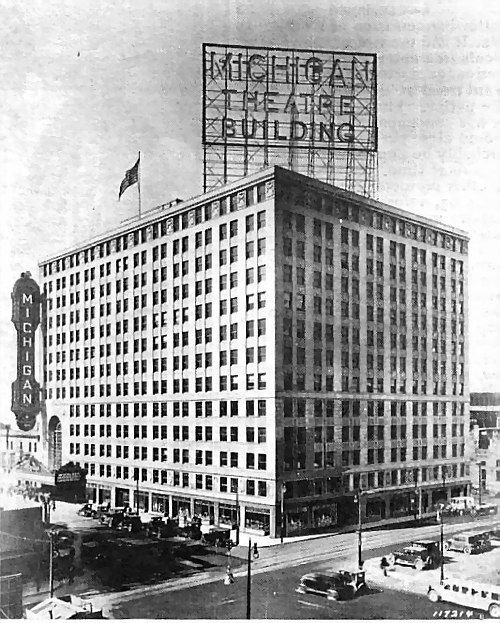
A Requiem for a Movie Palace
The horror of it all.
Believe it or not, the biggest enemy of the grand movie
palaces was the utilitarian parking lot. Because of the densly-packed buildings
in downtown districts across the United States, we lost a
significant number of our grand movie palaces to make way for many parking lots.
As a matter of fact, the Atlanta Fox Theatre was going to be razed in order to
have an open-air parking area for the BellSouth Tower
office complex that was going to be constructed on the opposite side of the
block the Fox sits on. Fortunately for the Fox as luck would have it, that
parking area was constructed directly next door to the Fox once the Fox was
saved.

Of all the palaces we have lost to parking lots, the most
horrible desecration to one of these Temples of Amusement still survives to
this day in the form of the ruins of what was the grand Michigan Theatre
located in downtown Detroit
Michigan.
The Michigan Theatre was a movie theater built in August
1926 by the architectural firm of Rapp & Rapp for Detroit philanthropist and movie theater
owner John H. Kunsky. With a seating capacity of 4000, the concert hall/movie
house was one of the largest in Michigan.
It's 10-story tall theater sign that read "M-I-C-H-I-G-A-N" which hung
over the equally impressive marquee stood out like a beacon on the
corner of the building could be seen all over the city. The ornate
palatial-style theater was the heart of Detroit's social scene for
many years. Yet after World War Two and the decline of intown theater
attendance due to urban spral, the theater fell on hard times and
its ownershil changed ownership several times through the 50s, 60s, and
70s. It
was subsequently used for various events including closed-circuit
television broadcasts
of the Detroit Red Wings ice hockey games for those who could not
attend the
actual event in nearby Olympia Stadium. In the 1970s, the theater was
used as a
nightclub and concert venue for rock bands before it was finally
shuttered for
good. 
The Michigan Theatre was permanently closed in 1976, a year
after the Atlanta Fox Theatre escaped the wrecking ball. When the Michigan Theatre Building
was constructed, like many palaces, the architects attempted to make the best
use of precious downtown real estate by constructing offices and stores around
the actual theater. In the Michigan’s
case, the retail and office space took up a majority of the building. When the
theater was shuttered in 1976, the building was still in very good condition
and it was decided to allow the building to stay, but the theater portion of
the building had to be used for something other than a theater or night club.
 It was decided that the rest of the building was in need of
its own parking facility to serve the building’s tenants and the theater
portion of the building would be converted into a multi-level parking deck. But
due to issues with the structural integrity of the building and cost of
demolishing the theater and then constructing a traditional decked parking lot
inside the building, it was decided to partially gut the auditorium and lobby,
then build the parking structure inside the remains of the theater!
It was decided that the rest of the building was in need of
its own parking facility to serve the building’s tenants and the theater
portion of the building would be converted into a multi-level parking deck. But
due to issues with the structural integrity of the building and cost of
demolishing the theater and then constructing a traditional decked parking lot
inside the building, it was decided to partially gut the auditorium and lobby,
then build the parking structure inside the remains of the theater!
I imagine (I do not know this for a fact) that most of the Michigan’s finer
appointments were removed from the building, then sold off to be used
elsewhere. Items that were deemed not worth the effort to remove were left in
place as the parking decks were constructed. Eventually, this created one of
the most surreal places in America.
Ramps going up and down to the levels of the parking deck occupy the formerly
ornate grand lobby. The stage area was left pretty much intact with even the
main curtain left hanging in the down position for many years before it eventually
disappeared. Directly across from the stage, you can clearly see the now-empty
projection booth and below it the remians of the balcony that looks like a gigantic electric
knife cut off its nose. Staircases that used to lead and up down to the balcony
areas and restroom stand open and cut off in mid-air. The ornate ceiling of the
auditorium remains above the top parking deck, much like an empty turtle shell.
Cars, Detroit's
primary industrial product, now fill the once-bustling theater along with the
derelict homeless . For many historians, the Michigans
has become a symbol of the decline of Detroit.
Behold the ruins of the once great Michigan Theatre...
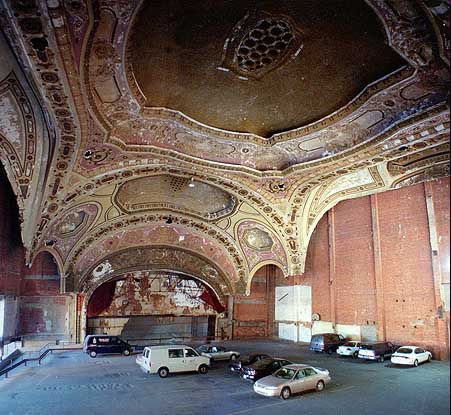

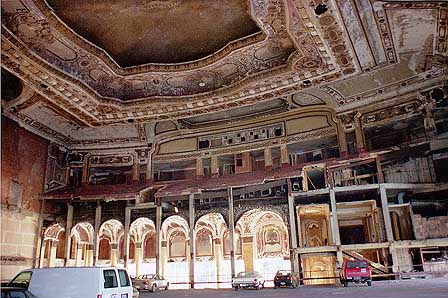


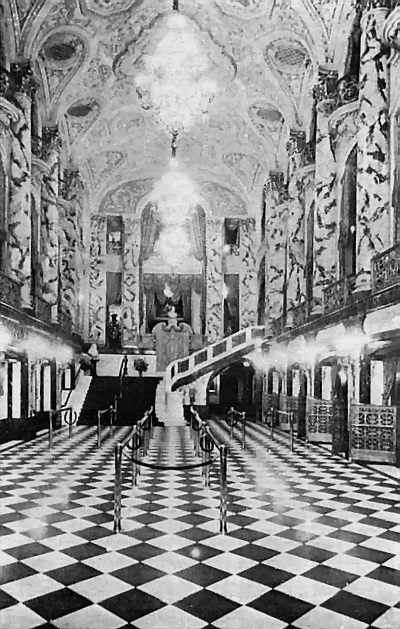



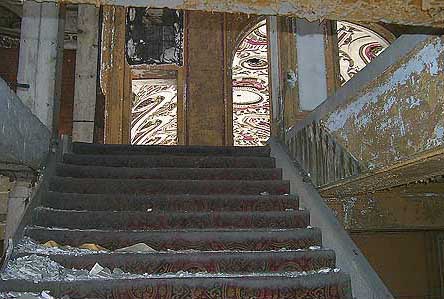





 It was decided that the rest of the building was in need of
its own parking facility to serve the building’s tenants and the theater
portion of the building would be converted into a multi-level parking deck. But
due to issues with the structural integrity of the building and cost of
demolishing the theater and then constructing a traditional decked parking lot
inside the building, it was decided to partially gut the auditorium and lobby,
then build the parking structure inside the remains of the theater!
It was decided that the rest of the building was in need of
its own parking facility to serve the building’s tenants and the theater
portion of the building would be converted into a multi-level parking deck. But
due to issues with the structural integrity of the building and cost of
demolishing the theater and then constructing a traditional decked parking lot
inside the building, it was decided to partially gut the auditorium and lobby,
then build the parking structure inside the remains of the theater!









